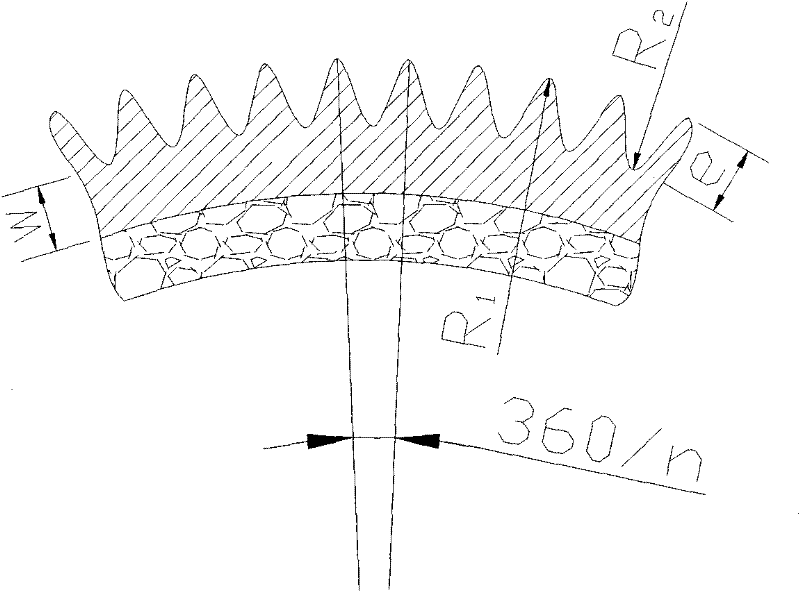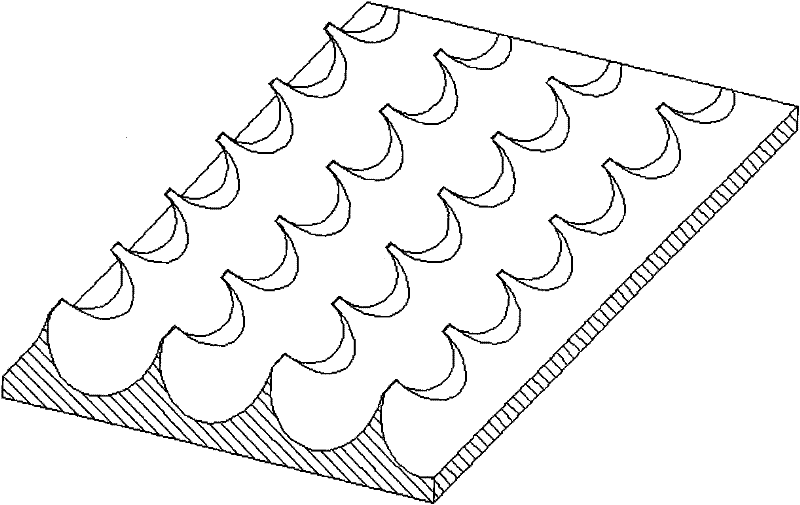Heat exchange tube with two reinforced surfaces
A heat exchange tube, double-sided technology, applied in the field of heat exchange tubes, can solve the problems of limited application and low heat transfer coefficient, achieve enhanced boiling heat transfer and condensation heat transfer, high total heat transfer coefficient, and enhanced boiling heat transfer Effect
- Summary
- Abstract
- Description
- Claims
- Application Information
AI Technical Summary
Problems solved by technology
Method used
Image
Examples
Embodiment 1
[0031] Such as Figure 1-3 As shown, on the basis of the copper light tube with a specification of φ32×3×1000mm, the surface specifications of the zigzag fin surface outside the tube are tooth height e=0.8mm, number of teeth n=50, tooth bottom thickness w=2.3mm, groove Depth h=1.2mm, slot width δ f =3mm, helix angle φ=45°. Tooth item radius R 1 =0.5mm, tooth bottom radius R 2 =0.8mm, the outer surface of the low fin is processed by precision machine tools on the outer surface of the smooth tube. The surface of the fin is rough and uneven. The angle makes the saw teeth stagger each other, which plays a role in disturbing the fluid flow state and promoting heat exchange. At the same time, the surface tension makes the liquid film on the fins thinner and flows to the lower edge of the heat exchange tube. Here, under the influence of gravity and capillary action, the heat exchange tube will form multiple liquid droplets with the tooth tip at the lower edge as the core. In the...
Embodiment 2
[0033] The specifications of the outer zigzag fins processed on the basis of brass tubes with specifications of φ22×2×1500mm are tooth height e=0.9mm, number of teeth n=40, tooth bottom thickness w=1.2mm, groove depth h=1.0mm , slot width δ f =2mm, helix angle φ=65°. In the condensation heat transfer experiment using refrigerant as the medium, the condensation heat transfer coefficient can be increased by 5 times. The specifications of the sintered-in-tube porous layer heat exchange tube are: the thickness of the porous layer is 0.25 mm, the equivalent pore diameter is 100 μm, and the porosity is 85%. In the boiling heat transfer experiment with acetone as the medium, the boiling heat transfer coefficient can reach 13 of that of a smooth tube times. The total heat transfer coefficient of the heat exchange tube can be increased by 3.5 times.
Embodiment 3
[0035] A double-sided enhanced heat exchange tube, the heat exchange tube includes a zigzag low-fin outer surface layer and a metal porous inner surface layer, and the low-fin outer surface layer is integrated with the tube wall.
[0036] The low-fin outer surface layer is processed by turning the outer surface of the carbon steel smooth pipe. The specification of the carbon steel smooth pipe is φ40×4×12000mm, and the specification of the low-fin outer surface layer is: fin The outer diameter of the chip is 40mm, the tooth height e=3mm, the number of teeth n=60, the tooth bottom thickness w=1.0mm, the groove depth h=2.5mm, and the groove width δ f =4mm, helix angle φ=35°; the thickness of the porous metal surface layer is 1mm, the porosity is 80%, and the aperture is 120 μm. The porous metal surface layer is added in metal iron powder, accounting for Iron powder weight 0.5% activator diammonium hydrogen phosphate, then add polystyrene binder and mix into mixed slurry, wherein ...
PUM
 Login to View More
Login to View More Abstract
Description
Claims
Application Information
 Login to View More
Login to View More - R&D
- Intellectual Property
- Life Sciences
- Materials
- Tech Scout
- Unparalleled Data Quality
- Higher Quality Content
- 60% Fewer Hallucinations
Browse by: Latest US Patents, China's latest patents, Technical Efficacy Thesaurus, Application Domain, Technology Topic, Popular Technical Reports.
© 2025 PatSnap. All rights reserved.Legal|Privacy policy|Modern Slavery Act Transparency Statement|Sitemap|About US| Contact US: help@patsnap.com



